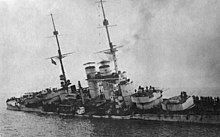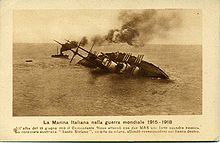SMS Szent István

| |
| History | |
|---|---|
| Name | SMS Szent István |
| Builder | Ganz & Company, Fiume |
| Laid down | 29 January 1912 |
| Launched | 17 January 1914 |
| Commissioned | 17 November 1915 |
| Fate | Sunk, 10 June 1918 |
| General characteristics | |
| Class and type | Tegetthoff-class battleship |
| Displacement | 20,000 t (19,684 long tons) standard |
| Length | 152 m (498 ft 8 in) |
| Beam | 27.9 m (91 ft 6 in) |
| Draught | 8.7 m (28 ft 7 in) |
| Propulsion | list error: <br /> list (help) 12 × Babcock & Wilcox boilers 4 × AEG-Curtis steam turbines, 26,400 hp (19,686 kW) 4 shafts |
| Speed | 20.4 knots (23.5 mph; 37.8 km/h) |
| Range | 4,200 nmi (7,800 km) at 10 kn (12 mph; 19 km/h) |
| Complement | 1087 |
| Armament | list error: <br /> list (help) • 12 × 305 mm (12 in) guns in triple turrets • 12 × 150 mm (6 in) guns in single casemates • 18 × 70 mm (3 in) guns in single mountings • 4 × 533 mm (21 in) torpedo tubes |
| Armour | list error: <br /> list (help) Belt, barbettes, turrets and conning tower: 275 mm (11 in) Deck: 35 mm (1 in) |
SMS Szent István was a dreadnought battleship, the only one built almost entirely by the Hungarian part of Austria-Hungary. Hungary was awarded the contract to build the battleship in return for agreeing to the immense funding of the Tegetthoff-class battleship, and named her after Hungary's first Christian king, Saint Stephen (Szent István in Hungarian).
Building
Szent István was laid down on 29 January 1912 at Ganz & Company's Danubius yard at Fiume, (the only large Croatian shipyard), was launched on 17 January 1914, and not named Szent István until 13 December 1915. This involved great expense, as the yard had hitherto only built smaller merchant ships for, amongst others, Austrian Lloyd, and therefore had to be itself re-fitted for the building of larger vessels.
She differed from her three sister ships in that she had a platform built around the fore funnel which extended from the bridge to the after funnel and on which several searchlights were installed. A further distinguishing feature was the modified ventilator trunk in front of the mainmast. She was the only ship of her class not to be fitted with torpedo nets.
Based at Pola she engaged in the usual patrols and bombardments along the Italian coast.
Sinking


At 3.30 a.m. on the morning of 10 June 1918, in the company of SMS Tegetthoff and seven other ships en route to attack the Otranto Barrage, Szent István was hit by two 45 cm torpedoes launched from the Italian MAS-15 Motor Torpedo Boat under Lt. Cdr. Luigi Rizzo. Many of the 1,087 crew were asleep, resting before the battle expected in a few hours. Immediate chaos soon changed into frantic efforts to save the vessel which was rapidly shipping water. The Tegetthoff, which had at first sped away from the vicinity of the torpedo attack, returned and took the Szent István in tow, in an attempt to reach the massive dry dock at Pula. However the pumps were unequal to the task before them and the ship continued to list slowly, sinking at 6.12 am off Premuda island. It is said she sank easily due to faults in the Tegetthoff class design: low displacement and high centre of gravity, together with the tremendous weight of the twelve 305 mm (12-inch) main guns. There were, however, only 89 dead, partly attributed to the fact that all sailors with the KuK Navy had to learn to swim before entering active service.
There is film footage of the last half-hour of the Szent István, taken by Lieutenant Mensburger from the Tegetthoff. The Szent István is one of only three battleships whose sinking was filmed, together with HMS Barham and USS Arizona. The Szent István film was later used to raise money for the Red Cross.
See also


- List of ship launches in 1914
- List of ship commissionings in 1915
- List of ships of the Austro-Hungarian Navy
- List of shipwrecks in 1918
- Tegetthoff class battleship
References
- Wagner, Dr.Walter, & Gabriel, Dr.Erich, Die 'Tegetthoff' Klasse, Vienna, January 1979, pps: 7-9 (technical details), 96-97 (10 stills from sinking footage with comment).
- Kennedy, Paul, The Sinking of the Szent Istvan, in The History of the First World War, BPC Publishing Ltd., Bristol, England, 1971, vol.7, no.14, pps:3072 - 3075.
